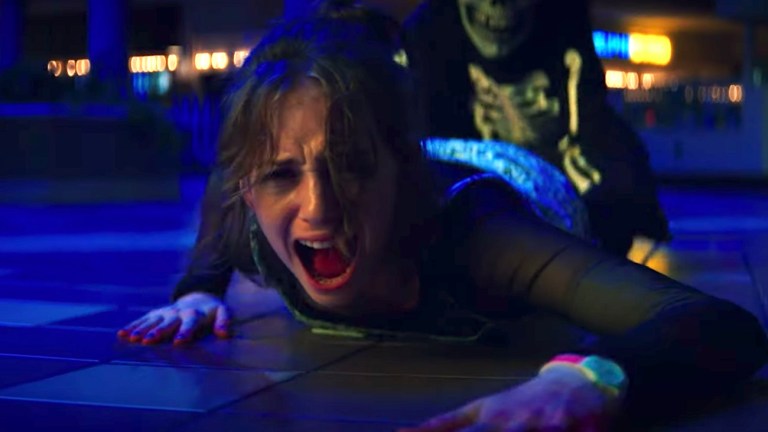How Fear Street Part 1 Tricks the Scream Generation
'90s horror movie fans reared on Wes Craven's Scream may be caught off guard by the first installment of Netflix's Fear Street Trilogy.

This article contains spoilers for Fear Street Part 1: 1994 and Scream.
An instantly iconic moment in genre cinema arrived during the opening scene of horror classic Scream back in 1996 when Drew Barrymore, one of the most in-demand young actresses at the time, met her unfortunate, gruesome fate at the end of the Ghostface killer’s knife. No one expected it. What kind of filmmaker would have the stones to murder their biggest star before the story even really began? The legendary Wes Craven, that’s who. And horror movies would never be the same again.
The ’90s-set Fear Street Part 1: 1994 may hope to appeal to fans of Scream and other horror bangers, but much like Scream it aches to subvert any dated expectations—and succeeds in a multitude of ways. The R. L. Stine book series adaptation lands on Netflix this month after a rocky road to the screen. Directed by Leigh Janiak, who helmed a couple of episodes of Scream: The TV Series after her debut horror movie Honeymoon snagged a ton of positive reviews, Fear Street: 1994 and its two sequels were originally developed at 20th Century Studios before the pandemic shuttered theatrical releases for a while.
Fear Street Part 1’s opening scene will likely seem predictable to Scream fans at first. Instead of Barrymore’s high schooler Casey, we are presented with Maya Hawke’s Heather. The actress is at the top of the film’s cast in plenty of listings, having previously broken out in the third season of Netflix’s flagship horror series Stranger Things as the ice cream scoop-slinging Robin Buckley, and having since appeared in Once Upon a Time in Hollywood.
Heather is closing a book store she works at in the mall when she hears odd noises and senses that she is being watched from the darkness when Fear Street Part 1: 1994 gets underway. We’re hit with a jump scare and a couple of Scream-y fake-out nods, including a ringing phone, before Heather realizes that it’s just her pal Ryan messing around, and they agree to meet up before they leave for the night. But the stalking continues after Ryan departs, and suddenly the chase is on as a masked killer not too dissimilar from Scream’s Ghostface hunts her down.
He stabs her and she falls on her back, helpless as he gets ready to end her life. Just as Casey does in Scream, Heather weakly raises her arm and pulls the Halloween mask off the killer to answer one final question before she expires. But unlike Scream, which cuts away at that very moment to preserve the mystery of the killer’s identity, Fear Street Part 1: 1994 shows us the killer’s face. It’s still Ryan! He’s shot dead a second later, seemingly ending the story before it really starts.
Just like that, we’re unsettled and don’t know what to expect next. Fear Street Part 1: 1994’s opening homage to Scream makes it clear almost immediately that the film is not content with playing in the same sandbox of horror tropes as its predecessors and inspirations. And it won’t be the last time that the movie refuses to stay in its lane.
After the shock of Hawke’s death, we get a swiftly edited—and very ’90s-esque—opening credits montage that lays most of the Fear Street trilogy’s lore out for us. The gaggle of teens we’re about to meet live in Shadyside, which happens to be the no-good sibling of its idealistic neighboring town, Sunnyvale. Shadyside makes for a wild slasher hellmouth, with a long history of slayings creating a sort of fever dream you might have after playing too much Dead by Daylight.
Horrifying murder sprees are the norm in Shadyside. The 1970s boasted their own Friday the 13th-style slasher at the local summer camp, and the 1600s gave birth to the legend of a Blair Witch adjacent curse. What monstrosity is waiting in the shadows for the young stars of Fear Street Part 1? Pretty much all of them, as we quickly find out when the movie taps into another major horror influence: Cabin in the Woods.
Drew Goddard’s 2012 gamechanger poses the question “what if there were a huge selection of boogeymen available to prey on some unsuspecting teens?” but Fear Street Part 1 sets out to prove that its own protagonists would do a far better job of things than the Cabin crowd by quickly pitting them against their own Shadyside horde.
Which is not to say that Fear Street Part 1 doesn’t embrace 1990s movie tropes elsewhere. There are the relentless needle drops of the first act, which cover everything from “Machinehead” to “Damn I Wish I Was Your Lover” to “Sour Times,” with a pace that gives you aural whiplash. There’s the candlelit vigil that turns nasty when some predictable toxic masculinity kicks in. There are visual homages to movies like I Know What You Did Last Summer. And some of the characters initially feel so two-dimensional that it’s easy to sink into the comfortable slasher movie mindset of cheering on their inevitable deaths.
But all this starts to fade away at around the 25-minute mark when Part 1 pulls its central characters into Shadyside’s supernatural web.
Deena, whose journey anchors the film, is a resourceful born leader who is ready to confront death at every turn. Her brother Josh is an early keyboard conspiracy theorist, on hand with some neat exposition whenever the film calls for it. Simon is a horny, goofy, drug dealing tagalong who has also been employee of the month—every month—and is often wonderfully sensitive. The film isn’t even halfway over before this gang have figured out what the score is and are plotting how they’re going to fight back as each of them refuses to fit into genre stereotypes.
But again, the film avoids rehashing a vintage scenario by dispensing with Cabin in the Woods’ more nihilistic and meta vibes. There’s no Control Room here; no one betting on the outcome. Fear Street would rather concentrate on the importance of teamwork and mutual respect in the midst of its endless cycle of violence—a tactic that feels like a fresh, essential strategy for a modern horror movie. Part 1 often wears its influences on its sleeve proudly, but it never seems particularly interested in copying them.
Then there’s that ending. In what is surely a first for the horror movie genre, two sequels are about to quickly follow that will push us deeper into Shadyside history. We are in the streaming age where studios are willing to risk a lot of cash on making a big debut splash, and the Fear Street Trilogy is surging into an unknown landscape by delivering three ambitious movies in three weeks. When the credits roll on Part 1, it could be easy to fall into the trap of knowing what to expect from a sequel posing as a prequel, but Part 1 has already succeeded in convincing us that we should set aside our expectations of what the trilogy ultimately hopes to bring to the horror genre.
